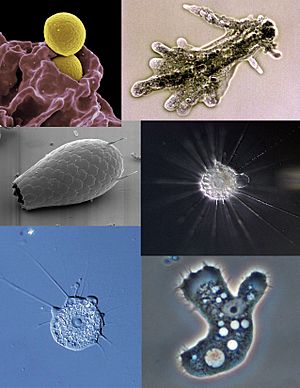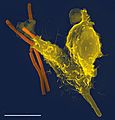Amoeba facts for kids

An amoeba (pronounced ah-MEE-bah) is a tiny living thing, often called an amoeboid. It's a type of cell or a unicellular organism, meaning it's made of just one cell. What makes an amoeba special is its amazing ability to change its shape! It does this by stretching out and pulling back parts of its body called pseudopods.
Amoebas are found in many places. You can often spot them in freshwater, especially near vegetation that is decaying in calm or slow-moving water. They also live in the bottom parts of some lakes, an area called the benthic zone.
Contents
How Amoebas Move and Eat
Amoebas move around and catch their food using their pseudopods. Think of pseudopods as temporary "false feet." These are bulges of the amoeba's cytoplasm (the jelly-like stuff inside the cell). Tiny structures called microfilaments push out the cell's outer skin, forming these pseudopods.
Amoebas don't have a mouth like we do. Instead, they eat by surrounding their food with their pseudopods and then pulling it inside their body. This process is like "engulfing" their meal. Since they don't have a fixed mouth, they can take in food from anywhere on their body!
What Amoebas Eat
Amoebas have different diets. Some amoebas are hunters; they eat bacteria and other small living things. Others prefer to eat dead organic material, which is like tiny bits of decaying plants or animals. Some amoebas can even absorb dissolved nutrients directly through their cell membrane using tiny sacs called vesicles.
Different Kinds of Amoebas
Amoebas are not all from the same family group. Instead, you can find amoeba-like cells in almost every major group of eukaryotic organisms. This means that amoeboid cells are not just protozoa, but also appear in fungi, algae, and even animals! For example, some of our own white blood cells move like amoebas.
Some well-known amoebas include:
- Naegleria fowleri: This is sometimes called the "brain-eating amoeba."
- Entamoeba histolytica: This one is a parasite that lives in the intestines and can cause a sickness called amoebic dysentery.
- Dictyostelium discoideum: This is a special kind of "social amoeba" or slime mould that can live as single cells but also come together to form a larger, multicellular group.
Why Amoebas Are Studied
Scientists love to study amoebas in the laboratory. They are easy to keep and observe. Because of this, amoebas are often used to learn more about protozoa and to show how cells are built and how they work.
The "giant amoebae," Chaos carolinense and Amoeba proteus, are especially popular for study. They are often grown and examined in classrooms and labs around the world.
Images for kids
-
The forms of pseudopodia: polypodial and lobose; monopodial and lobose; filose; conical; reticulose; tapering actinopods; non-tapering actinopods.
-
A Neutrophil (a type of white blood cell) engulfing anthrax bacteria.
-
Trophozoites of the disease-causing Entamoeba histolytica with swallowed red blood cells.
See also
 In Spanish: Ameboide para niños
In Spanish: Ameboide para niños






